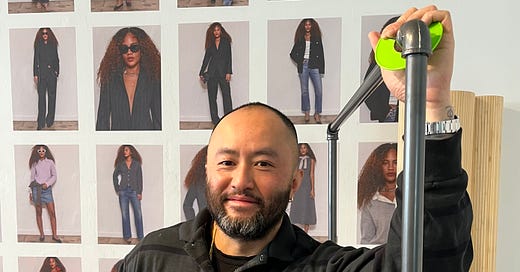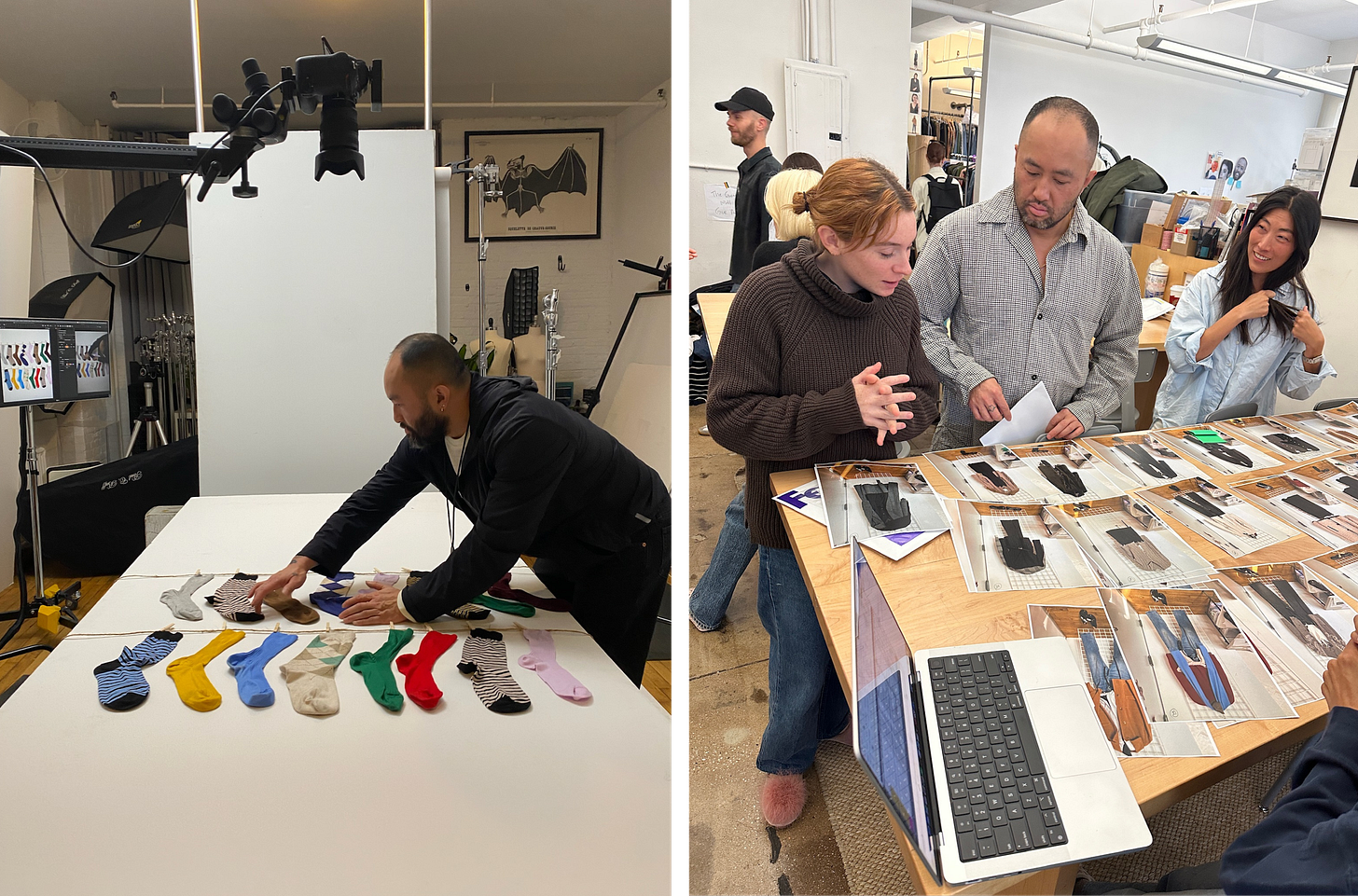Somsack on Somstack
The creative director of Alex Mill makes great tees — and great newsletters.
It used to be that brand creatives were a little bit mysterious; their homes, habits, and personal whims revealed only in interviews and magazine spreads. Thanks to the Great Newsletter Boom of the early 2020s, things are changing. Some of these oracles of style and taste are leaving their distant temples to join Substack.
It sounds like I’m making this out to be an unromantic concession to the content economy, but I actually think it’s a fun development. More substantial than an Instagram post and less polished than a traditional marketing email, the best of these newsletters offer a peek into the minds of the people who make your most beloved things. They have an off-the-cuff air. The language is specific and idiosyncratic — clearly written by the brand creative themselves, not by a team of publicists and copywriters. That last point is crucial. It’s got to feel real.
One of my favorites is Somstack, a newsletter written by Somsack Sikhounmuong, creative director of the clothing brand Alex Mill. It’s casual, funny, and punchy, full of the kind of things you actually want to learn from a professional tastemaker: Paris travel recs, useful styling tips (a.k.a. “SomHACKS”), gift ideas, late-night internet finds (“inSOMnia”), and essays about sneaking into fashion week as a Parsons student. “You” is often “u,” making Sikhounmuong’s posts feel a bit like a text from a friend.
The newsletter also has the potential to introduce a wider audience to a designer who has historically worked more behind the scenes. If you didn’t already know Sikhounmuong’s name, you probably know his work. For over two decades, he has been making American wardrobe essentials for style-conscious young people — the jeans, T-shirts, and jackets that you throw on every single day. He was the creative director of Madewell, effectively dressing a generation of millennial women, before heading to J.Crew and then Alex Mill, which is currently making the best cotton tees on the market and generally sucking my household’s wardrobe budget dry.
Sikhounmuong is inquisitive and disarmingly low-key. When we hopped on a Zoom call to talk about his newsletter, he told me that he’d started it at the suggestion of Rose Anderson, a member of Alex Mill’s marketing team who has her own art-focused newsletter. Although his newsletter necessarily promotes the brand, it also seems like something of a relaxed experiment. “It’s been a fun exercise in using a different set of brain muscles. I don’t write like that at work, ever. I keep my emails to three words: yes, no, maybe,” Sikhounmuong told me. He still tries to keep his posts comparatively short (Graydon Carter would approve), with lots of iPhone pictures, turning each one out in about three hours.
Sikhounmuong has experienced many of the small crises that other newsletter writers face: guilt about not posting with strict regularity, weeks of rumination about his next topic, hesitance about divulging personal anecdotes, and imposter syndrome about having a Substack at all. “Do people even want to know what I eat or think is good?” he asked. “I’ve been getting over that a little bit and deciding, no, there will be people who enjoy it!” Besides, he reminds himself, it’s supposed to be fun.
Somstack, a personal newsletter from a seasoned retail executive, could be considered a metaphor for Alex Mill as a whole. The brand was launched in 2012 by Alex Drexler; in 2019, Mickey Drexler, the retail legend behind the golden ages of Gap and J.Crew, joined his son’s leadership team. Sikhounmuong came along too. Despite this serious pedigree, the Alex Mill office felt intimate and pleasantly scrappy when I stopped by in February, a cozy labyrinth of paper-strewn desks, mood boards, packaged orders, and clothes, which were stacked on shelves, hung on racks, and encased in plastic storage tubs.
Anderson gave me a tour of the office, introducing me to Alex Drexler, who had been intently tapping away on his keyboard, and Jordan Dennett, the director of men’s design, who sits in a corner near Sikhounmuong and women’s director Alice Park. Taped to the walls were hand-drawn cards, pictures of Gene Kelly and Shalom Harlow, and sketches from an office costume competition. Sikhounmuong, Anderson, and another colleague had spent several evenings crafting wearable tiered cakes worthy of Marie Antoinette’s court, only to miss out on the top prize. Anderson insisted the competition was rigged. “Politics,” muttered Sikhounmuong when I asked him about it.
When Sikhounmuong left J.Crew, he knew the scale of his next job needed to be different. “We have a small and mighty team. We’re more nimble. I think the size of the ship is much easier to steer, which has been refreshing,” he said. He’s more involved in each step of the creative process than he used to be, and he works more closely with the elder Drexler than before, when they were separated by departmental layers. “I didn’t spend this much time with him every single day,” Sikhounmuong said. “When we opened up Alex Mill’s Rock Center store, it was just me and Mickey doing the walk-through with the architect and store manager.”
On the day of my visit, Sikhounmuong was planning to do some sketches for an upcoming collection, which he likes to do at one of the office’s communal tables. (This isn’t always the best place to focus; the week prior, he built a fortress out of boxes to deter interruptions from colleagues.) Sketching is one of his favorite activities and an early step in the design process: Once he has a sense for the fabrics that will be used for a given season, he starts drafting sketches, which will later be turned into technical drawings that serve as a blueprint for clothing samples. Some designers like to sketch each item individually, but Sikhounmuong draws full outfits, which helps him work out the proportions of a sweater or a pair of trousers.
The Alex Mill team might have a specific goal in mind for an item — with the Nico cardigan, they wanted to find the sweet spot between chunky and lightweight, for everyday use — but Sikhounmuong is also open to happy surprises. Early samples of the Chiltern jacket had a straight silhouette, but, seeing it in person, the team wondered what might happen if it had a fuller shape. They decided to not overthink that impulse and ordered a new sample. In Sikhounmuong’s view, the resulting jacket sits appealingly between familiar and unusual.
“Sometimes I feel that when you’re so painstakingly focused on the details, it doesn’t make the thing that much better. You can almost beat it to death,” he said. “Sometimes when you let go a little bit, funny things happen that you didn’t plan for.”
This attitude explains why, when Sikhounmuong took up ceramics during Covid, he gravitated toward the loose playfulness of hand-building with clay. (But also: “Within an hour, I knew I was not meant for the wheel.”) His newsletter has a similar sense of spontaneity. His Paris travel guide includes expert level recommendations, but it’s also an essay about seizing an opportunity to discover new spots after a horde of Taylor Swift concertgoers ran him out of his usual haunts. (“Millions of Swifties EVERYWHERE. And the aforementioned hotels, reservations, and tickets I usually book?! Gone! Sold to the Swifties!”)
I was wondering how he keeps all of that curiosity and creativity flowing, so I asked Sikhounmuong what he considers to be the most important part of his day — that one essential thing that supports the whole operation. “It’s so boring,” he replied. But he told me anyway: It’s the hour and a half at the end of the day, when he flops in bed and, just like the rest of us, scrolls on his phone, watching tennis recaps and old music videos, and laughing at memes and whatever silliness the internet sends his way.
He feels a little guilty about all that screen time — and I get that, the same way I understand feeling guilty about falling behind on your newsletter schedule — but, he said, creative people need time to do nothing. “I remind myself of that every time I’m scrolling and doing nothing,” he said. “Like, this is good, this is good. I should be doing it.”








This was so fun - thank u for coming behind the scenes!